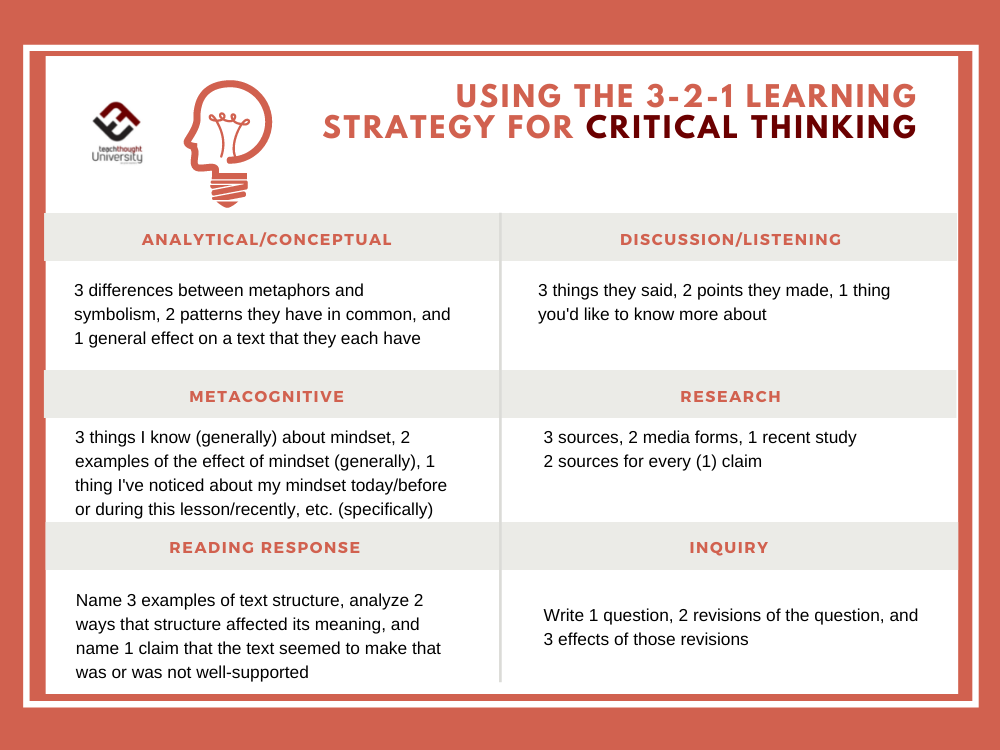
What Is The 3-2-1 Strategy And How Can It Be Used For Critical Thinking?
by Terry Heick
What’s the 3-2-1 strategy? The 3-2-1 strategy is simply a format that can frame–well, really anything.
Examples Of The 3-2-1 Strategy
It doesn’t even have to be about about teaching and learning. You might ask someone to name…
3 of your favorite genres of music, 2 of your favorite songs, and 1 pattern you noticed making that list of genres and songs
3 cities you’ve visited, 2 of your favorite memories of those 3 cities, and 1 place you’d like to go next
3 causes of pollution, 2 solutions that could help address those causes, and 1 thing a person can do every day to help immediately/have an immediate effect
You get the idea. It’s just a simple way to frame a topic or task, making it seem accessible and ‘quick.’ For teachers, this means the possibility of higher student engagement and more possible uses in your classroom, from journal or discussion prompts to assessment forms or exit slips.
The most common use of 3-2-1 I’ve seen is in response to a reading or lesson–usually 3 things you learned, 2 things that made you curious or confused, and 1 most important thing you learned or should do with what you’ve learned.
Using The 3-2-1 Learning Strategy For Critical Thinking
In 15 Reflection Strategies To Help Students Retain What You Just Taught Them, I wrote, “3-2-1 is a tried-and-true way to frame anything from a pair-share or journal entry (e.g., ask students to write 3 things they think they know, 2 things they know they don’t know, and one thing they’re certain of about a topic) pre-assessment to a post-assessment (e.g., list three ways your essay reflected mastery of skill X, two ways skill Y still needs improving, and one way you can make your argument stronger in the next five minutes) to a reflection of the post-assessment.”
In going back and rereading the post recently, it occurred to me that the 3-2-1 (or 1-2-3–or even just 2-1 and 1-2) format might be a simple strategy for critical thinking. The ‘3-2-1’ sequence itself doesn’t hold significant potential except for its ability to frame the potential of other strategies.
Note that these are just rough examples of using the 3-2-1 for learning. Feel free to take any of these and improve them or create your own based on an idea you get reading them. : )
Also note, I use sometimes vague or imprecise words like ‘thing’ and ‘name’ and ‘could have’ and ‘might have.’ I did this to make it general enough to be plainly useful to a range of grade levels of content areas. The ‘thing’ can be anything from fractions or the water cycle to a discussion about Shakespearean sonnets. (In that way, it’s similar to the 6 Domains Of Cognition TeachThought Learning Taxonomy.)
The point I hope to make is that the 3-2-1 strategy is a simple way to frame anything–which means it’s a useful tool for teaching critical thinking.
Analytical/Conceptual
3 differences between metaphors and symbolism, 2 things they have in common, and 1 general effect on a text that they each have
3 underlying assumptions of democracy, 2 common misunderstandings of democracy, 1 reason democracies have endured as a form of modern government
You could also have asked students to name 3 strengths of democracy, 2 forms of democracy, and 1 way it might have to evolve to maintain relevance in a changing world (misinformation, deep fakes, propaganda, partisanship, etc.)
Write 3 questions at the recall or understanding level, 2 questions at the ‘apply’ level, and 1 question at the evaluate level
Discussion/Listening/Debate
3 ways you agree, 2 ways you disagree, and 1 thing you learned (or that surprised you) during your conversation
3 things they said, 2 points they made, 1 thing you’d like to know more about
Metacognitive
3 things I know (generally) about mindset, 2 examples of the effect of mindset (generally), 1 thing I’ve noticed about my mindset today/before or during this lesson/recently, etc. (specifically)
3 ways my thinking occurs easily or naturally for me, 2 ways my thinking requires focus or effort on my part, 1 adjustment I can make in response
3 things I remember thinking during the lesson, 2 things I remember doing during the lesson, and 1 thing I could’ve done but didn’t
Time-Based
Spend 3 minutes summarizing, 2 minutes clarifying, and 1 minute writing one sentence that concisely summarizes the ‘thing’
3 things I could do with what I’ve learned, 2 things that other people do with this kind of knowledge or skill, 1 thing I am going to do with what I’ve learned
3 similarities, 2 differences, 1 question-to-guide-future-learning
3 things I learned, 2 things that were a bit confusing, 1 ‘big idea’ that sums up the relevance of it all
3 open-ended questions, 2 closed questions, 1 deepening question
3 clarifying questions, 2 probing questions, 1 contextualizing question
Lesson Planning: What are three ways I have designed with enough flexibility to meet the needs of a range of learners? What are two questions or challenges I anticipate? If they can only learn one thing from this lesson, what do I want it to be (ideally in one sentence)?
Curriculum Planning: What are three most important ‘big ideas’ in this curriculum? (Obviously, this could be any number–six, ten, etc.) How can they unify the ‘less important’ or less broad ideas? What are curriculum planning strategies I can use to promote enduring understanding (or critical thinking, transfer, etc.)? What is one change I can make to this curriculum to make it more flexible for all learners?
See 20 Types Of Questions For Critical Thinking
Reading Response Prompt Examples
Non-fiction text/simple: Name 3 things you remember or learned from the reading, 2 things that made you confused or surprised, and 1 thing you’d like to learn more about
Non-fiction text/less simple: Name 3 examples of text structure, analyze 2 ways that structure affected its meaning, and name 1 claim that the text seemed to make that was or was not well-supported
Fiction: Describe 3 ways the author developed the protagonist over the course of the book, describe 2 ways that development affected the plot’s development, and identify and explain 1 change the author could’ve made in that development and how that change would have affected the meaning of the text/your enjoyment of the text, etc.
Using 3-2-1 To Guide Inquiry Examples
Identify 3 places your inquiry could ‘start,’ identify 2 pros and cons of each, then create 1 driving question to guide your inquiry
Write 1 question, 2 answers, and 3 follow-up questions
Write 1 question, 2 revisions of the question, and 3 effects of those revisions
Write 3 questions, 2 possible answers each, and 1 implicit idea in either
Research
2 sources for every (1) claim
3 sources, 2 media forms, 1 recent study
3 sources published within the last 5 years, 2 sources published between 5 and 20 years ago, 1 source published 20+ years ago
Using The 3-2-1 Learning Strategy For Critical Thinking
